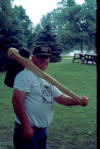

![]()
![]()

The Grossman Cache with big Mama, in the lower left, above the North arrow.(click images to enlarge)
 (Photo by John Whitaker)
(Photo by John Whitaker)
(Photo by Dick Grybush)
Larry tries out "Big Mama" at the Evergreen Lake Knap-in on Saturday, July 17th, 2004.
Here, Wayne Clark (6' 7", 315 lbs) from Illinois, swings big Mama with a vengeance. At this point, Larry is more worried about the handle breaking than the stone breaking. You can tell by the look on Wayne's face that he is not babying the celt at all.
As you can see, Wayne sends the chips flying. The only problem is that the log is too small and bounces, absorbing the blow. The axe will probably work better if we can find a larger log to chop.
Here, Stan Teske, (5" 8", 180lbs) from Minnesota, uses a different technique. He lets the celt swing between his legs and swings it up to drop on the log. It seems to work well for him demonstrating that technique may have much to do with the ability to use such a large celt.
At the Native American Festival ( Sept. 24, 25, and 26, '04) in Evansville Indiana, a new technique is used. There doesn't seem to be a great advantage to using a large axe over a much smaller one when cutting notches in logs such as in canoe building. It was decided to try to cut notches in a log and use the large celt to dislodge the chunk between the notches. The problem was that the log was dried pecan instead of a green log. Most wood cutting with stone celts works much better on green logs but, sometimes, you have to work with what you've got on hand.
(Photo LK) Here's
the first notch cut with a much smaller celt.
(Photo LK) Here's
both notches with Big Mama ready to cut out the chunk.
 (photo
Fred Bollinger) Removing
the chunk.
(photo
Fred Bollinger) Removing
the chunk.
(Photo
LK) After
about 10 chops, it's still not out.
(Photo
LK) Another
5 chops yields results.
 (Photo LK) Here's
the chunk that was removed.
(Photo LK) Here's
the chunk that was removed.
The handle makes the celt very hard to control. Let's try moving the handle down, closer to the mid-point of the stone. September, 2006.


 Larry's celt demo at Rabbit Stick 2007.
Larry's celt demo at Rabbit Stick 2007.
Larry demonstrates the way a celt can be removed by hitting the back end over a log. Notice, the celt in mid air.
"Big Mama" removed a smaller piece than expected.
 The handle broke but the chunk was removed with the shorter handle.
The handle broke but the chunk was removed with the shorter handle.
Larry poses with the removed chunk and the broken "Big Mama".
Now, to make a new handle and find a large, green log.